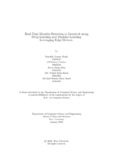| dc.contributor.advisor | Chakrabarty, Amitabha | |
| dc.contributor.author | Ghosh, Kawshik Kumar | |
| dc.contributor.author | Islam, MD.Fahim-Ul | |
| dc.contributor.author | Efaz, Abrar Ahsan | |
| dc.contributor.author | Ratul, Md. Wahid Sadiq | |
| dc.contributor.author | Shatil, Md Zaid Hassan Khan | |
| dc.date.accessioned | 2023-05-30T09:19:33Z | |
| dc.date.available | 2023-05-30T09:19:33Z | |
| dc.date.copyright | 2023 | |
| dc.date.issued | 2023-01 | |
| dc.identifier.other | ID 19101057 | |
| dc.identifier.other | ID 19101294 | |
| dc.identifier.other | ID 19101368 | |
| dc.identifier.other | ID 19101194 | |
| dc.identifier.other | ID 18201192 | |
| dc.identifier.uri | http://hdl.handle.net/10361/18377 | |
| dc.description | This thesis is submitted in partial fulfillment of the requirements for the degree of Bachelor of Science in Computer Science, 2023. | en_US |
| dc.description | Cataloged from PDF version of thesis. | |
| dc.description | Includes bibliographical references (pages 45-48). | |
| dc.description.abstract | The livestock industry is a vital component of the global economy, with a value estimated at over $1.4 trillion. However, the health of livestock animals is frequently
threatened by infectious diseases, which can have serious consequences for the industry and the economy. Bovine mastitis is one such disease that is prevalent and
costly to treat. It is caused by bacterial infection of the mammary gland in cows
and can have severe impacts on the dairy industry. In developing countries like
Bangladesh, where the livestock sector is a significant contributor to the national
economy, mastitis is a major concern. It is estimated that this disease costs the
dairy industry millions of dollars each year in Bangladesh, due to reduced milk production, increased treatment costs, and culling of infected animals. The economic
impact of mastitis can be particularly significant in a country like Bangladesh, where
the livestock sector plays a vital role in the economy. In order to overcome this issue,
this paper presents a real-time system for detecting mastitis in livestock using Deep
Learning and Machine-Learning techniques leveraging edge devices. The proposed
system aims to provide a timely and accurate diagnosis of clinical mastitis, ultimately reducing costs and improving the efficiency of treatment. By utilizing deep
learning and machine learning techniques, the system is able to analyze data from
edge devices and make accurate predictions about the presence of mastitis. This
can help farmers and veterinarians identify infected animals and take appropriate
action to prevent the spread of the disease. In the proposed system, various Deep
Learning and Machine Learning algorithms were utilized for classification, and a
comparison was made based on their accuracy and performance. The models that
performed best with the highest accuracy were selected for further use. InceptionV3
and Random Forest algorithm were chosen for Deep Learning and Machine Learning, respectively, and had an accuracy of 99.34% and 99% respectively. A review
of other papers that have used classification techniques for detecting mastitis shows
that the models proposed in this paper have demonstrated better accuracy in the
diagnosis of mastitis in livestock. The real-time system for detecting mastitis in livestock presented in this paper has the potential to significantly reduce the economic
impact of this disease in the dairy industry of Bangladesh and other developing
countries. By providing a timely and accurate diagnosis, the system can help to
improve treatment efficiency and protect the health and productivity of livestock
animals. In doing so, this system can have positive impacts on the livestock industry and the global economy by improving the health and productivity of livestock
animals and reducing the costs associated with mastitis. | en_US |
| dc.description.statementofresponsibility | Kawshik Kumar Ghosh | |
| dc.description.statementofresponsibility | MD.Fahim-Ul-Islam | |
| dc.description.statementofresponsibility | Abrar Ahsan Efaz | |
| dc.description.statementofresponsibility | Md. Wahid Sadiq Ratul | |
| dc.description.statementofresponsibility | Md Zaid Hassan Khan Shatil | |
| dc.format.extent | 48 pages | |
| dc.language.iso | en | en_US |
| dc.publisher | Brac University | en_US |
| dc.rights | Brac University theses are protected by copyright. They may be viewed from this source for any purpose, but reproduction or distribution in any format is prohibited without written permission. | |
| dc.subject | Deep learning | en_US |
| dc.subject | Edge devices | en_US |
| dc.subject | Mastitis | en_US |
| dc.subject | Livestock | en_US |
| dc.subject.lcsh | Machine learning | |
| dc.subject.lcsh | Cognitive learning theory | |
| dc.title | Real-time mastitis detection in livestock using deep learning and machine learning leveraging edge devices | en_US |
| dc.type | Thesis | en_US |
| dc.contributor.department | Department of Computer Science and Engineering, Brac University | |
| dc.description.degree | B. Computer Science | |

